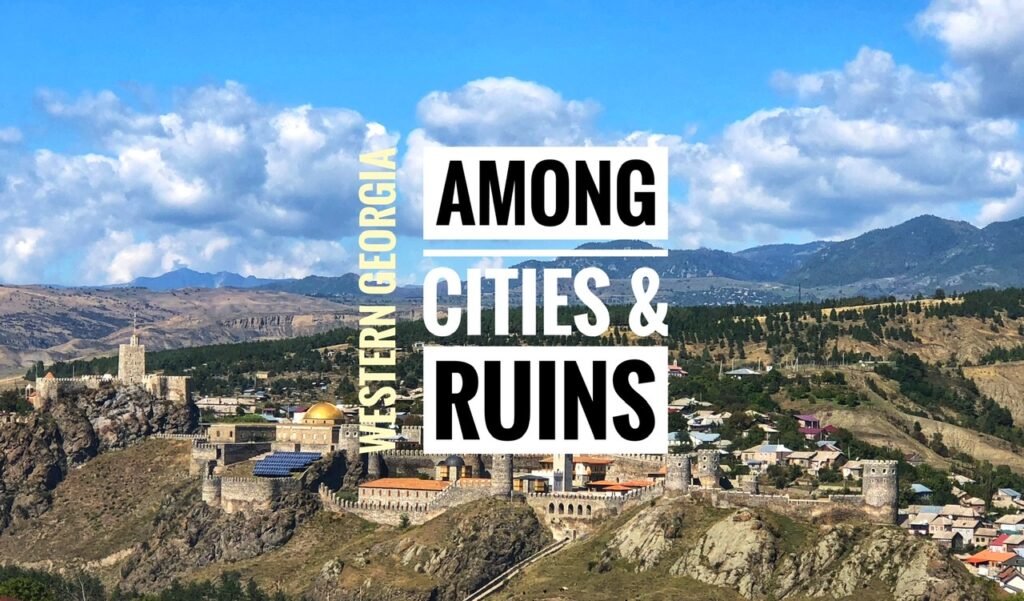
The Republic of Georgia is fast becoming the tourism hot spot for travelers in-the-know for Eastern Europe. And for good reason. The Georgian people are some of the most welcoming and warmest we’ve ever met, the cities and culture are dynamic and storied, the tucked away villages and ruins draw you in with their authenticity and charm, the nature is dramatic, and the food… the food is truly one of the world’s most under recognized culinary gems and deserves a post of its own, (which we’ll get to later.) But we begin with Batumi, on the Black Sea, where we departed our ferry and started our Georgian odyssey…
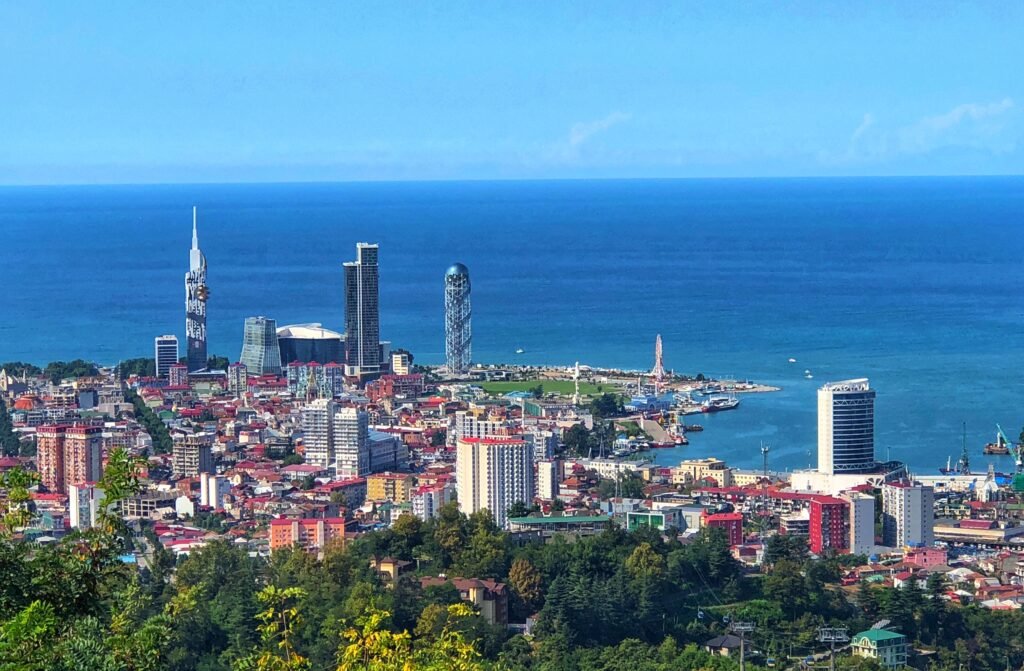
Batumi
Batumi is also known as the pearl of the Black Sea, it sparkled and gleamed with neon and bright lights from afar as we arrived on our Black Sea ferry from Odessa Ukraine at 11 pm. We were also delighted to find the next day that Batumi is also ringed by dramatic mountains. Despite our late arrival time we were welcomed into this shiny and cosmopolitan new world ($12/night in a modern high rise) by our Airbnb host, Maia, with wine and kisses. Literally kisses… when she discovered we were Americans. We’ve found this to be a common reaction when people learn we are American (Georgians really seem to have a particular affinity for our country, and several have told us they want to move to NYC.)
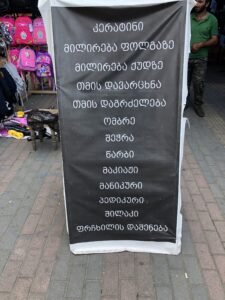
The Georgian alphabet, consisting of 33 letters, is one of the world’s oldest still used languages. Interestingly, there is no distinction between upper and lower case. After two weeks here, we have only mastered four words: gamarjoba (hello), madloba (thank you), ara (no), and gamarjus (cheers, the last of which has been drilled into our heads with the consistent wine and cognac welcomings we’ve been receiving.)
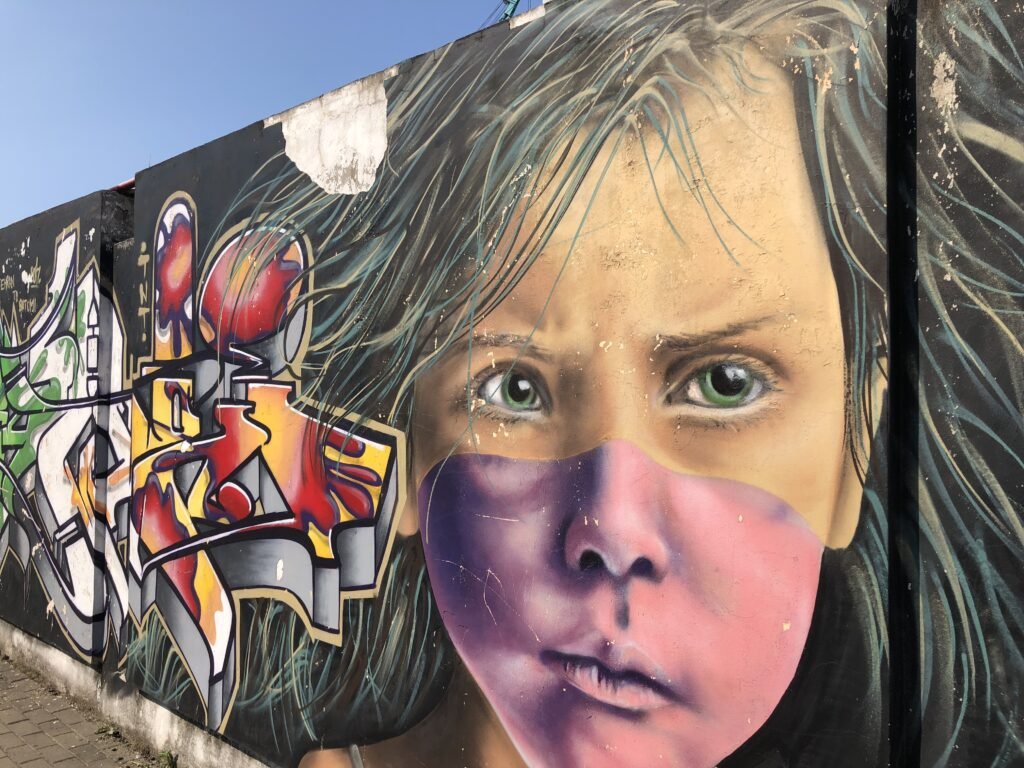
The street art is also fabulous!
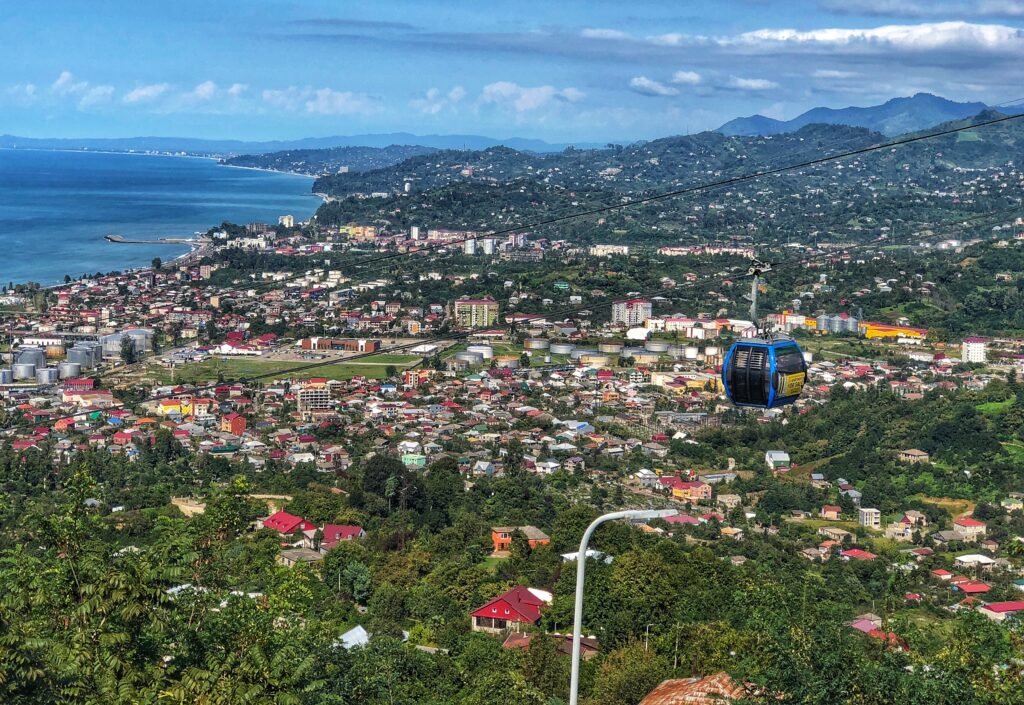
At the top of Batumi after riding up in the cable car.

Street markets and fresh produce are everywhere in Batumi!

Although Batumi has a lovely Ferris wheel on the seaside promenade, a second one can be found (!) about 15 stories up built into this sky scraper!
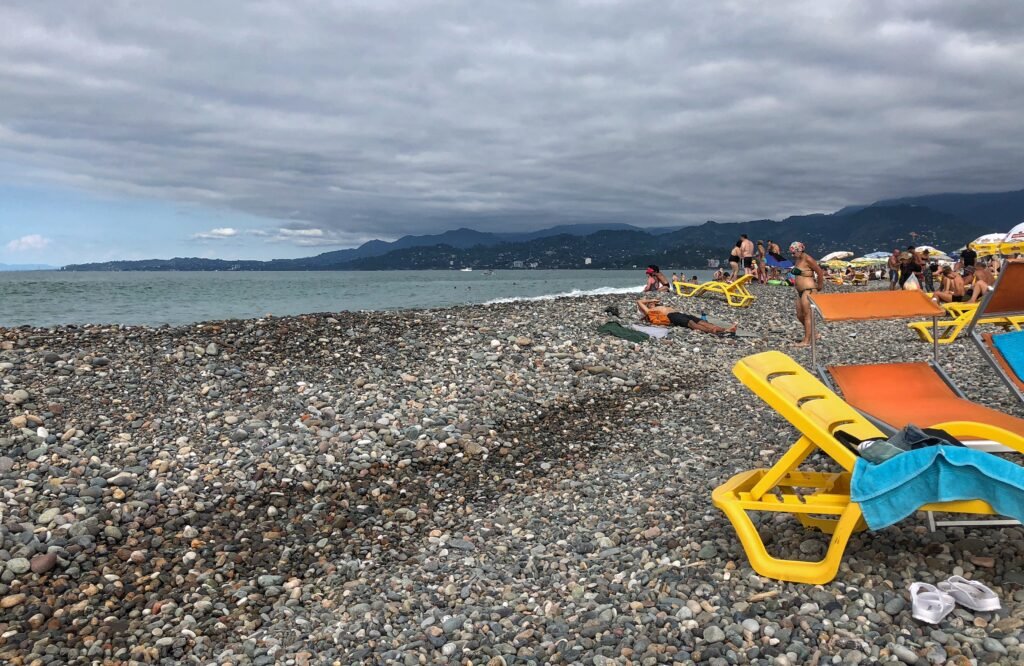
Also, we made sure to pause for a couple hours to lay out on the sea. The beaches consist of smooth pebbles and rocks, so it’s helpful to rent a lounge chair for 1 Lari (about $.40) for the afternoon.

We also thought the architecture on this building was interesting…almost Asian!
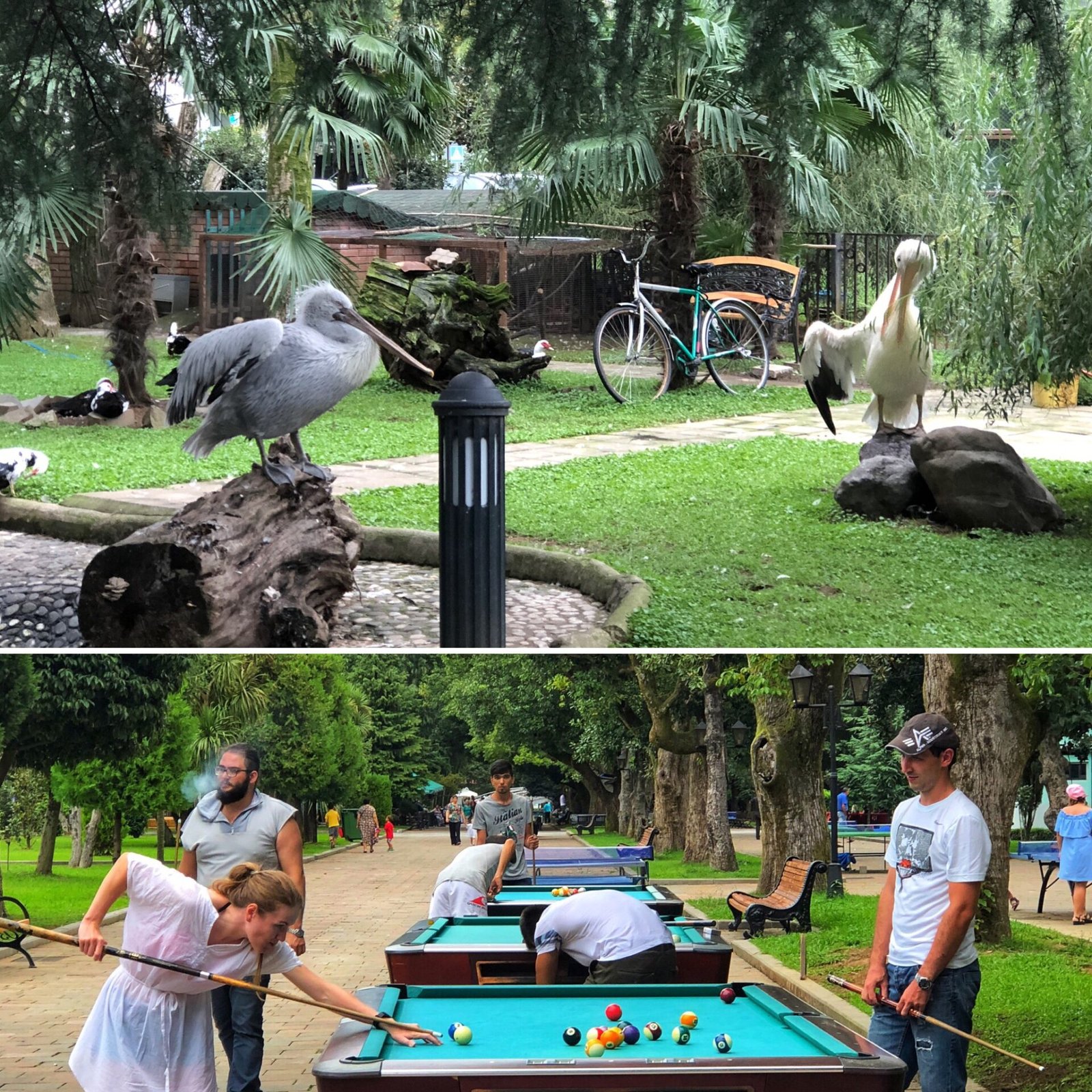
Strolling the streets and really great seaside promenade is a wonderful way to spend the day. Greenspaces are abundant in Batumi and this park even featured storks (no babies included) and outdoor pool tables.
Kutaisi
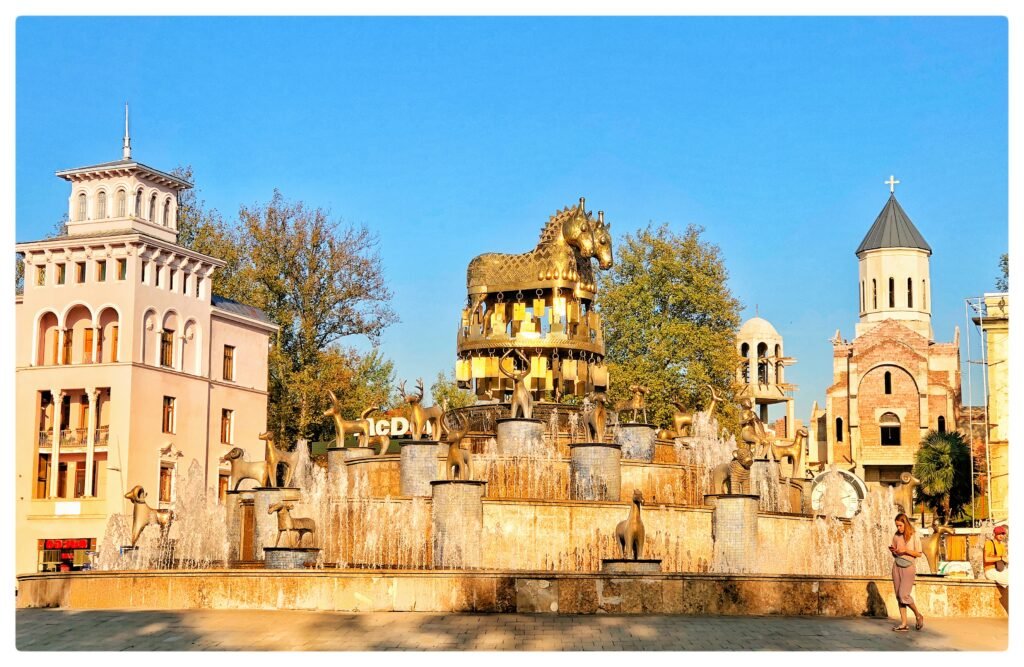
The next city we arrived in was Kutaisi, the second biggest in Georgia. Colchis Fountain is a recent addition in Byzantine-style made from a replica of gold plated jewels.
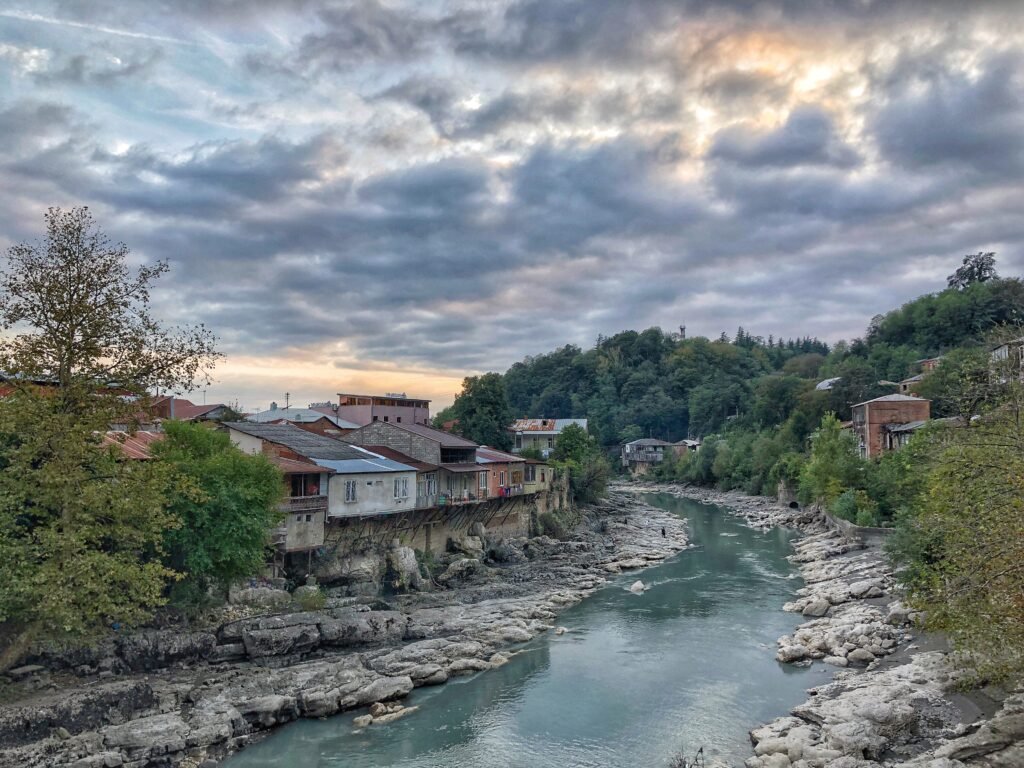
The Rioni river which flows through the heart of Kutaisi and splits the old town from newer. Looking at the riverbank and its smooth white riverside rock we imagined centuries of people washing and whipping their clothes clean against these ideal washing rocks.
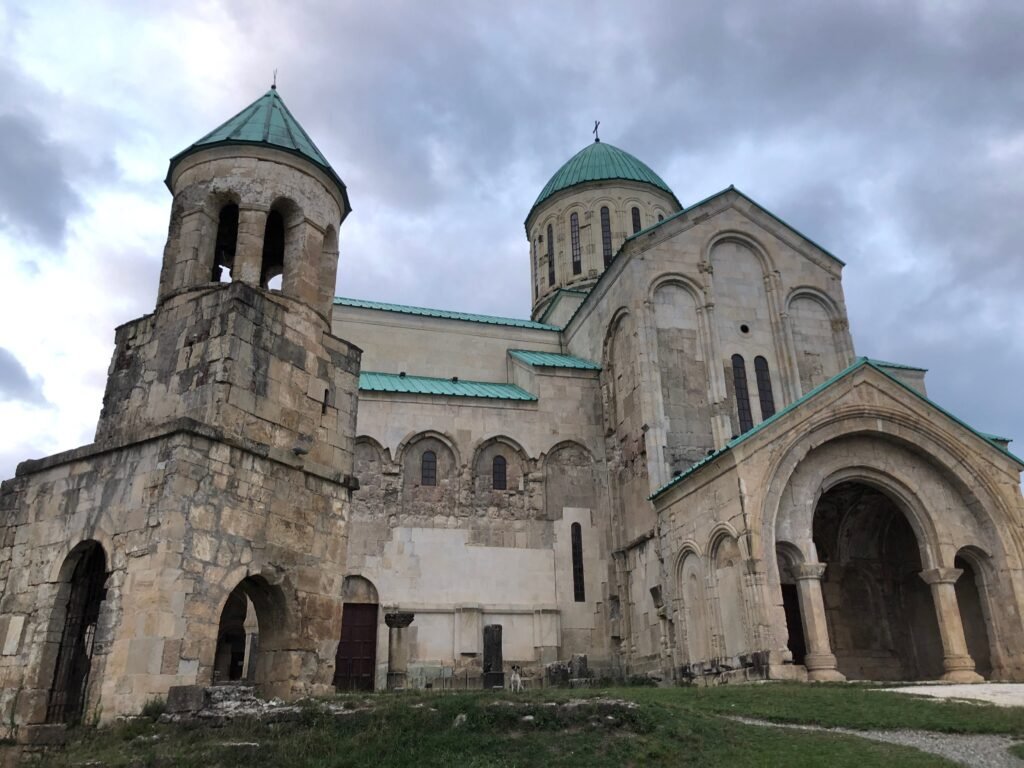
The Bagrati Cathedral in Kutaisi, inscribed on the UNESCO world heritage list in 1994, sits high up on a Rioni River cliff overlooking Kutaisi. The majestic Cathedral originally built in 1003, has been almost completely rebuilt (2009 to 2012) after a Turkish explosion in 1692 had reduced it to ruins.
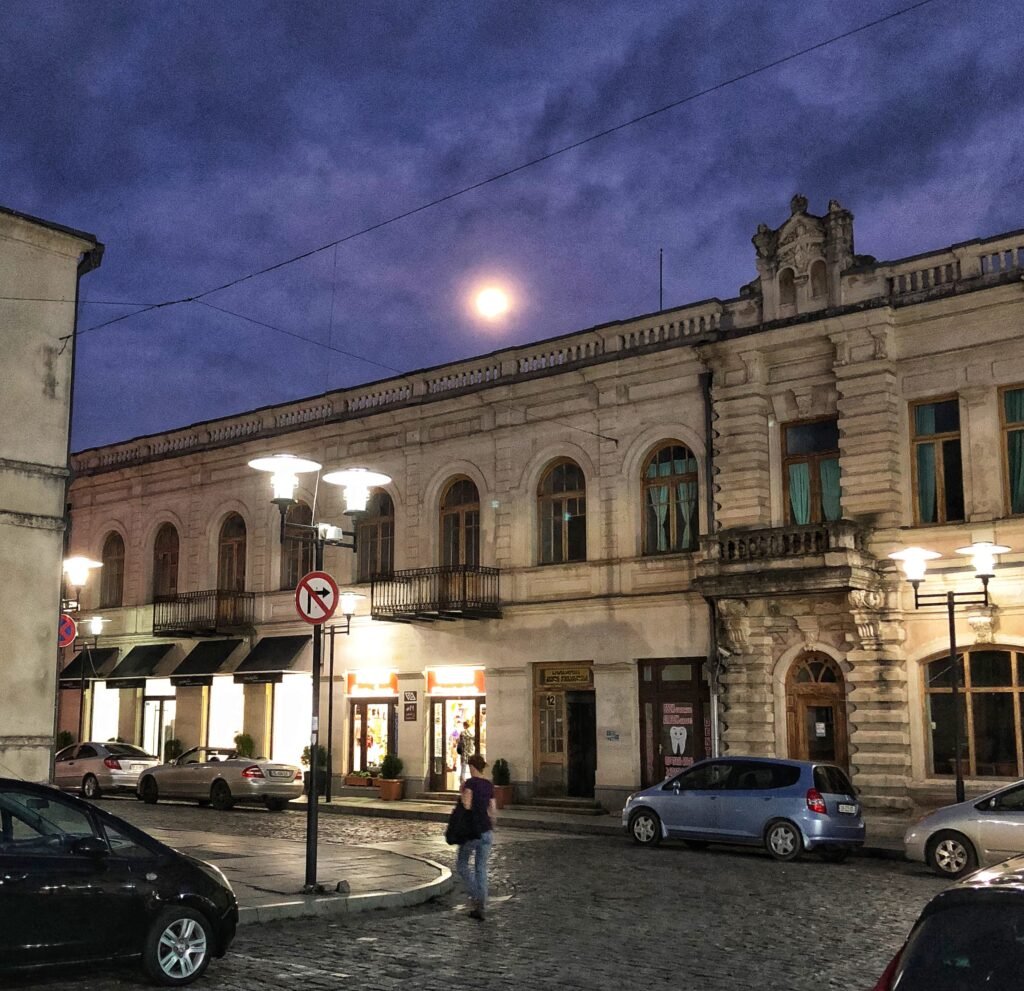
Wandering the city streets on a lovely full moon evening in Kutaisi.
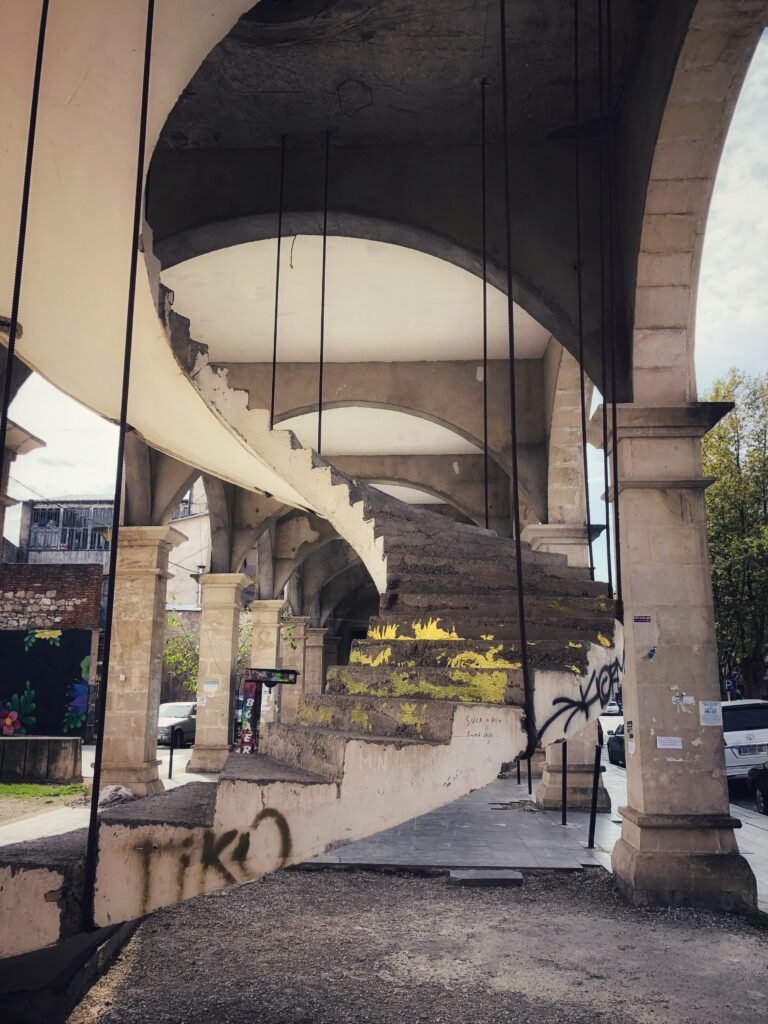
Floating staircase, to nowhere… a leftover disused relic from grander days.
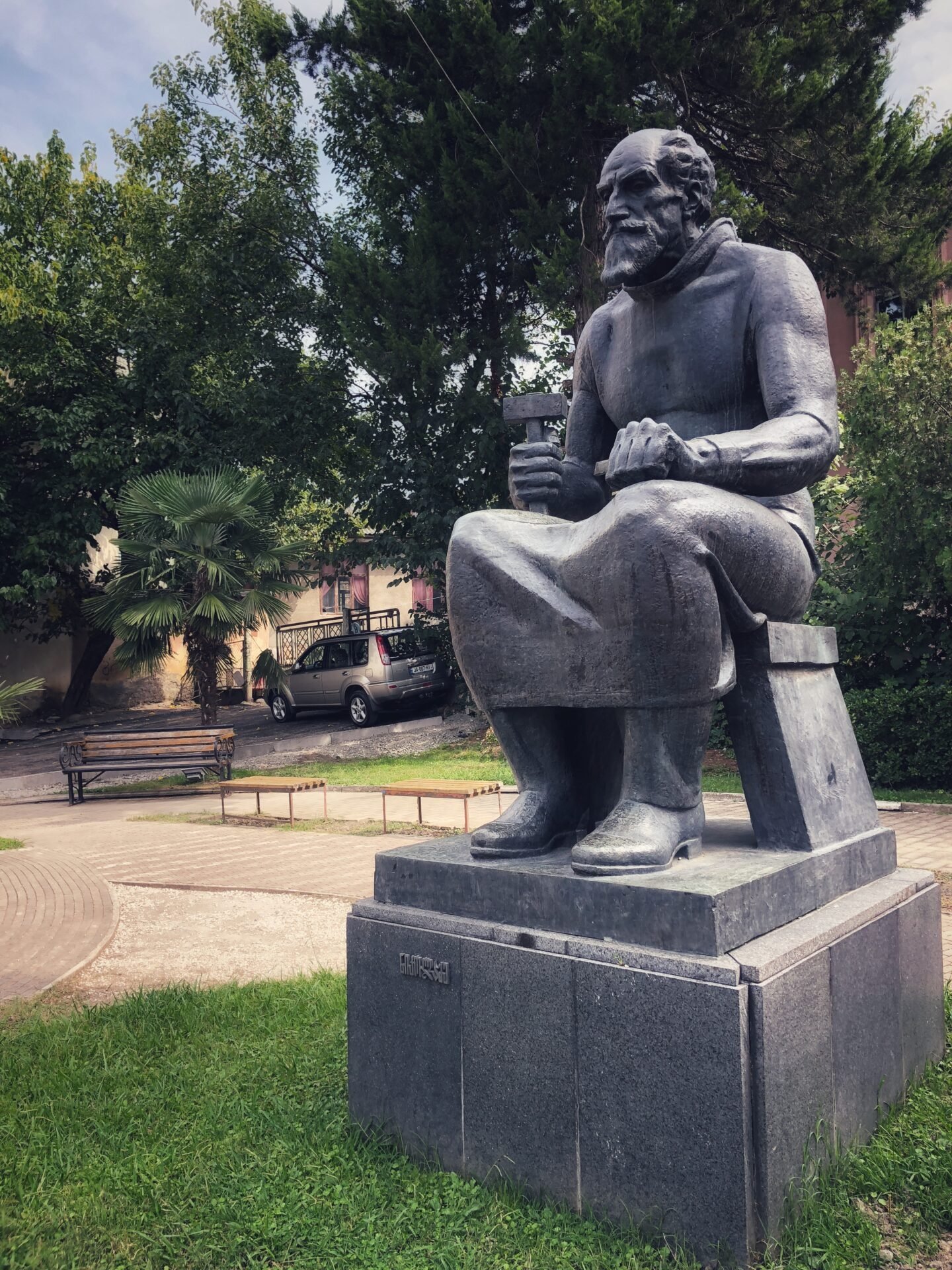
David The Builder, a Georgian monarch and hero from 12th Century who was instrumental in making the capital Tiblisi a grand city and restoring greater Georgia after invading armies ransacked it.
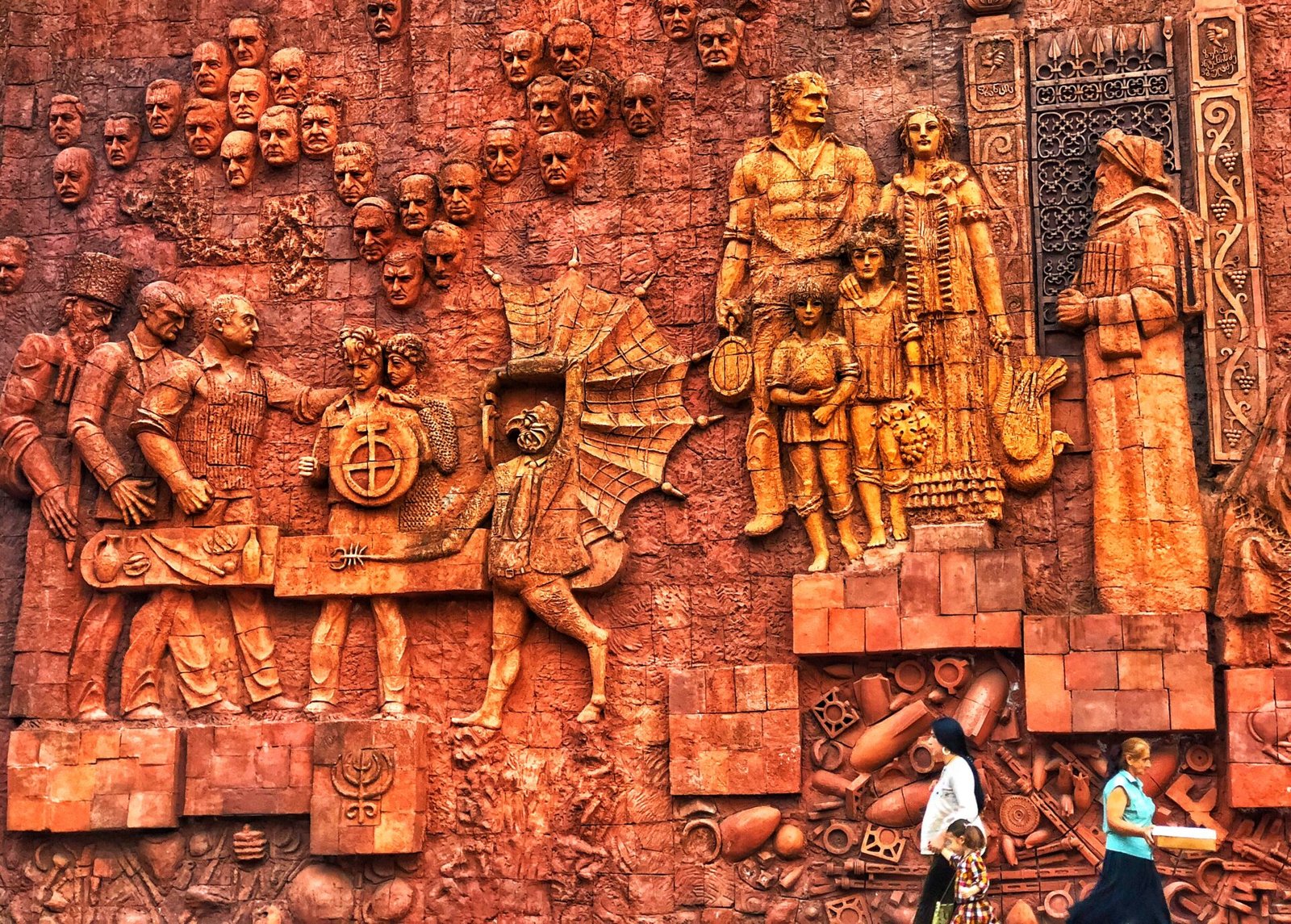
This mural on the side of the market features floating heads and inevitably tells a story of Georgian history.
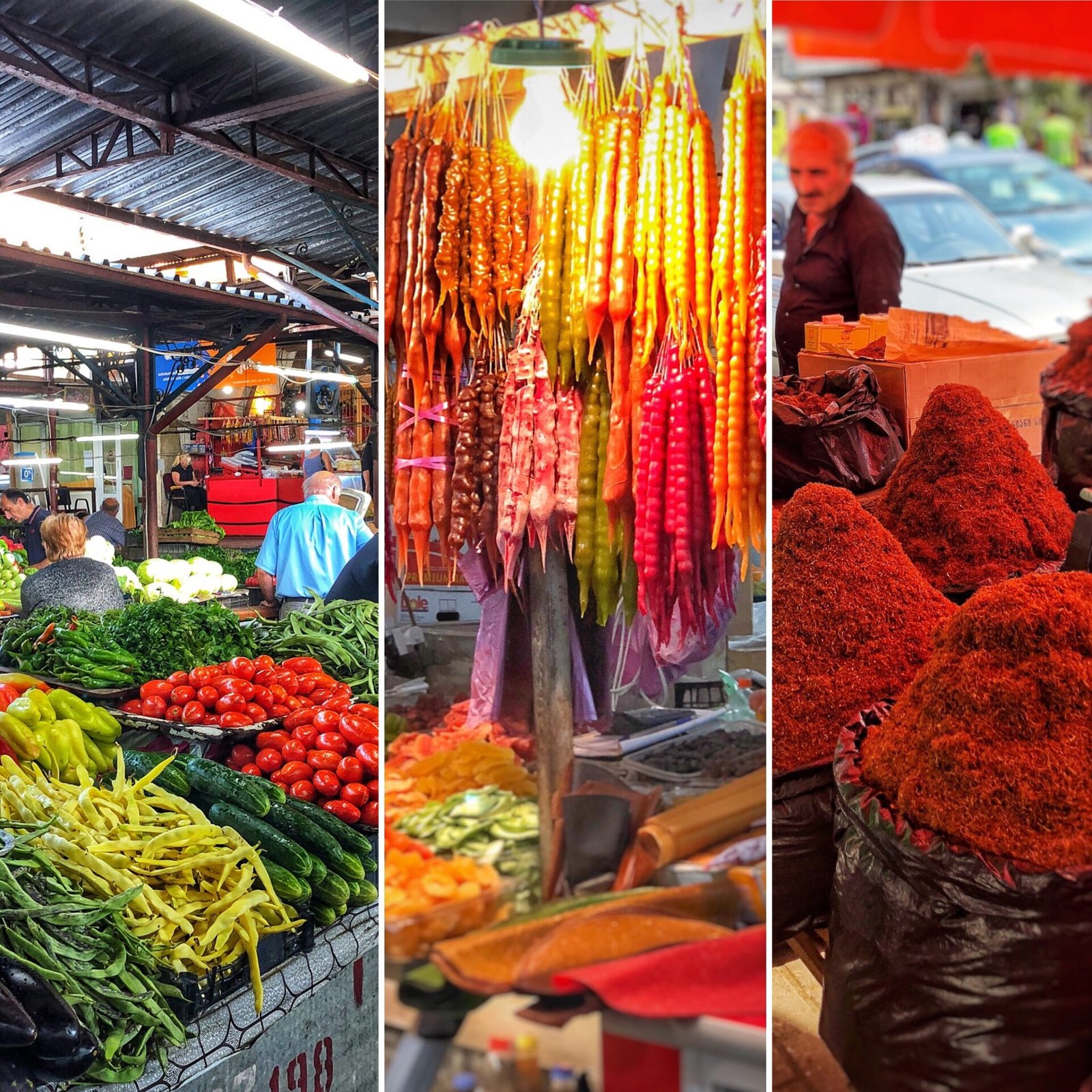
The Kutaisi market is the biggest and most colorful we found in Georgia. It’s clean and well organized… we found all that we needed to prepare our own version of a Georgian salad. In fact, while on the hunt for these ingredients Mandy purchased a head of romaine lettuce for what she thought/heard was 5 Lari ($2). We went on our merry way continuing our shopping when, after a couple minutes we were tapped on the shoulder by the lettuce seller, she deposited 4.50 Lari into Mandy’s hand… Mandy had misheard the price, .50 not 5 for the lettuce (about $.20). It was an incredibly honest gesture. This was not the first time we have noticed that Georgians hold being honorable in high esteem… we pay the same amount for everything as the locals do right down to the .01. Also, pictured are the ever popular churchkela (walnut strings dipped in grape juice syrup), and bags of tobacco being sold in bulk quantities.
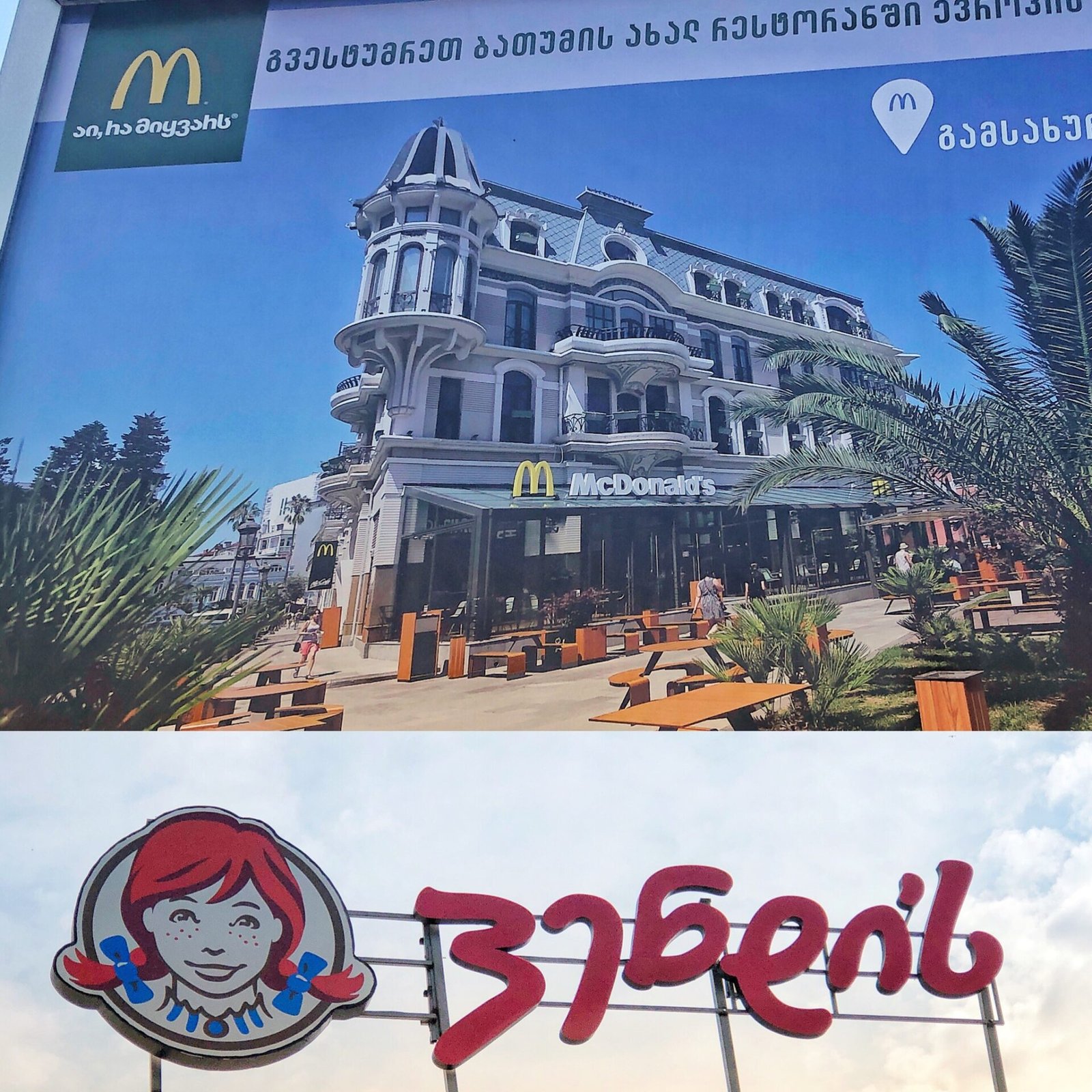
We couldn’t help noticing the Wendy’s in Kutaisi because this is the first Wendy’s we’ve seen abroad. Also, the Georgians seemed very excited about McDonald’s. In our Airbnb description it even said, “close to the new McDonald’s.” Needless to say we chose the delicious Georgian food over a Big Mac.
Akhaltsikhe
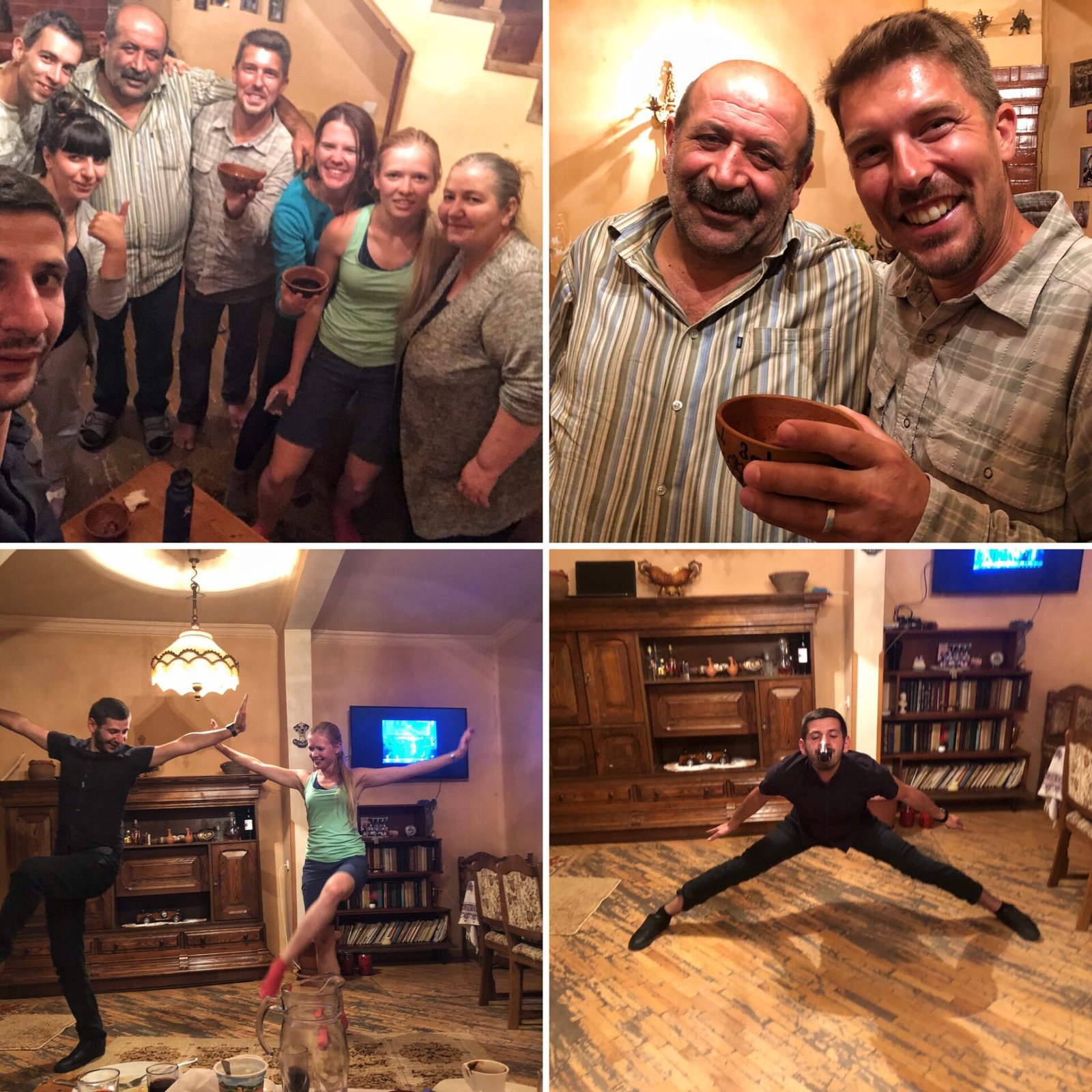
We were lucky enough to experience the ultimate in Georgian hospitality when we checked into “Old House Guesthouse” in the small town of Akhaltsikhe. Mama Cico, or “house boss,” as she called herself, without a doubt ran the show. But, her entire family welcomed us with open arms into their home and family. Cico cooked us lavish, and copious amounts of Georgian food for every meal encouraging us to “EAT, EAT!!” & “DRINK, DRINK!!” In fact, she humorously scolded us the one time we foolishly tried to go to a restaurant during our three day stay, saying, “my tourists, no eat at restaurant!!!” She also taught Mandy to make Khinkali, (more on that later), while Dad David helped pour us endless amounts of his homemade cognac and Geogian wine (gvino) while we stumbled through conversations using Google translate and laughter, and we even had a “dance party” on the last night with fellow tourists, Anna and Piotr from Poland. Their son, Zaali, and daughter Tamo even taught us some dance moves during one nights festivities. Zaali, we learned had only just recently retired from the Georgian National Ballet, an esteemed position in Georgia. He showed off his talents by doing the splits and drinking a glass of wine at the same time (when his mother wasn’t watching! 🙂 Our time with the Old House family in Akhaltsikhe was priceless and memorable… exactly the kind of warm and delightful travel experience that makes you realize how connected everybody on this earth is.

Zaali and his niece, four-year Tekla, who took after her uncle’s dance moves and entertained us by dancing ON HER TOES from the moment we arrived!

Rabati Fortress, the crown jewel of Akhaltsikhe, Georgia, is a huge castle city built in 13th Century which includes a church, mosque, minaret, and synagogue which speaks to the impressive religious tolerance and progressive attitude the Georgians have had throughout the centuries. Today, through diligent reconstruction, visitors have the chance to “sleep in a castle,” as there is also a restaurant, hotel and spa. Although we didn’t stay there, we did splurge and used the day spa… because, why not.

A lovely vineyard inside the fortress.
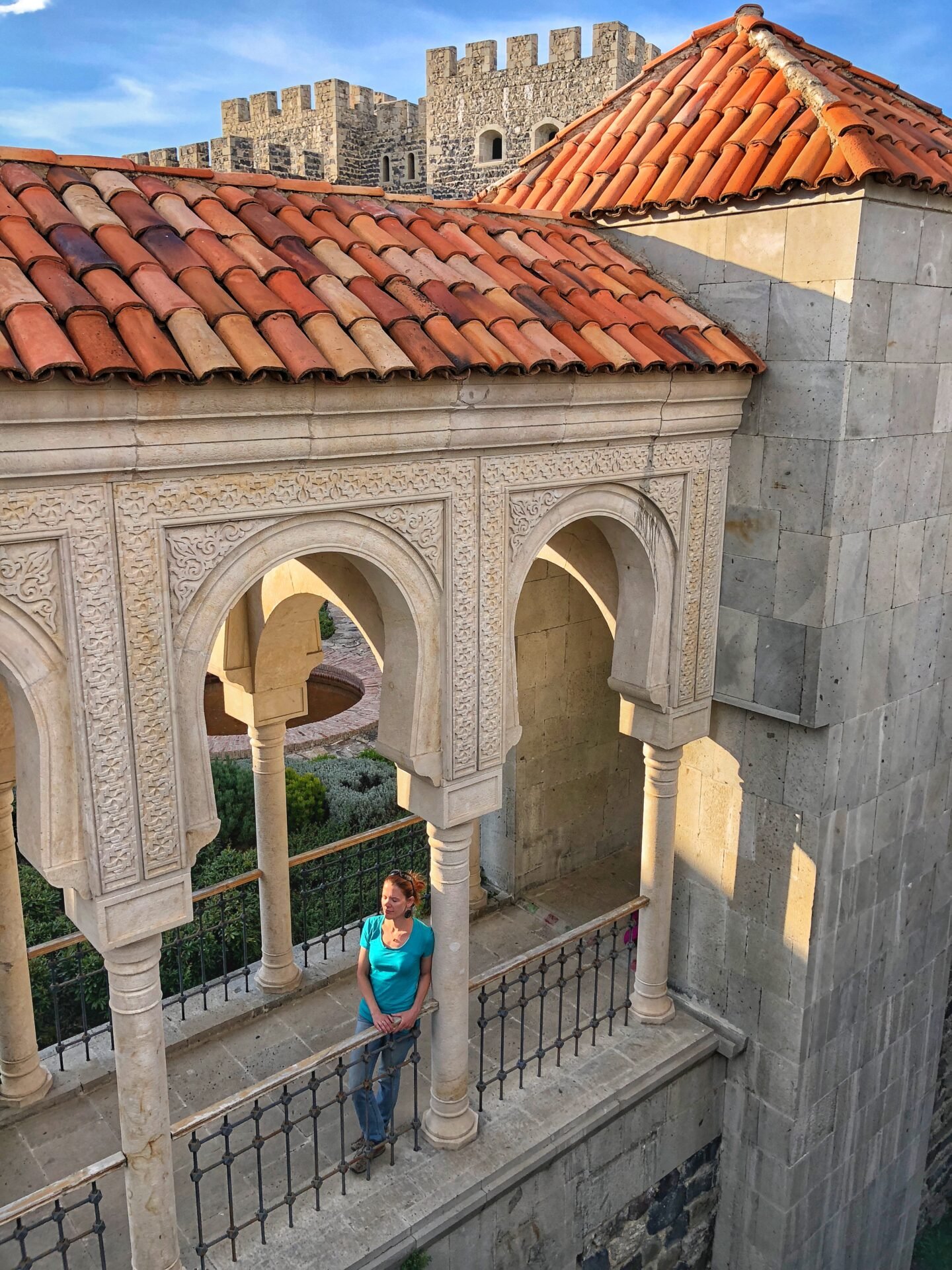
Mandy has a peaceful moment while Greg enjoys the architecture (and looking at Mandy).

The view of the fortress and the surrounding mountains from the Rabati castle tower.

The fortress tower and beautiful Georgian flag.

A view of the main mosque and it’s golden dome. Our first of the trip!

Inside the mosque of the Rabati Castle complex. Built during Persian occupation of the fortress, on the grounds of a previous cathedral, the architect is said to have modeled the mosque after the Hagia Sophia.
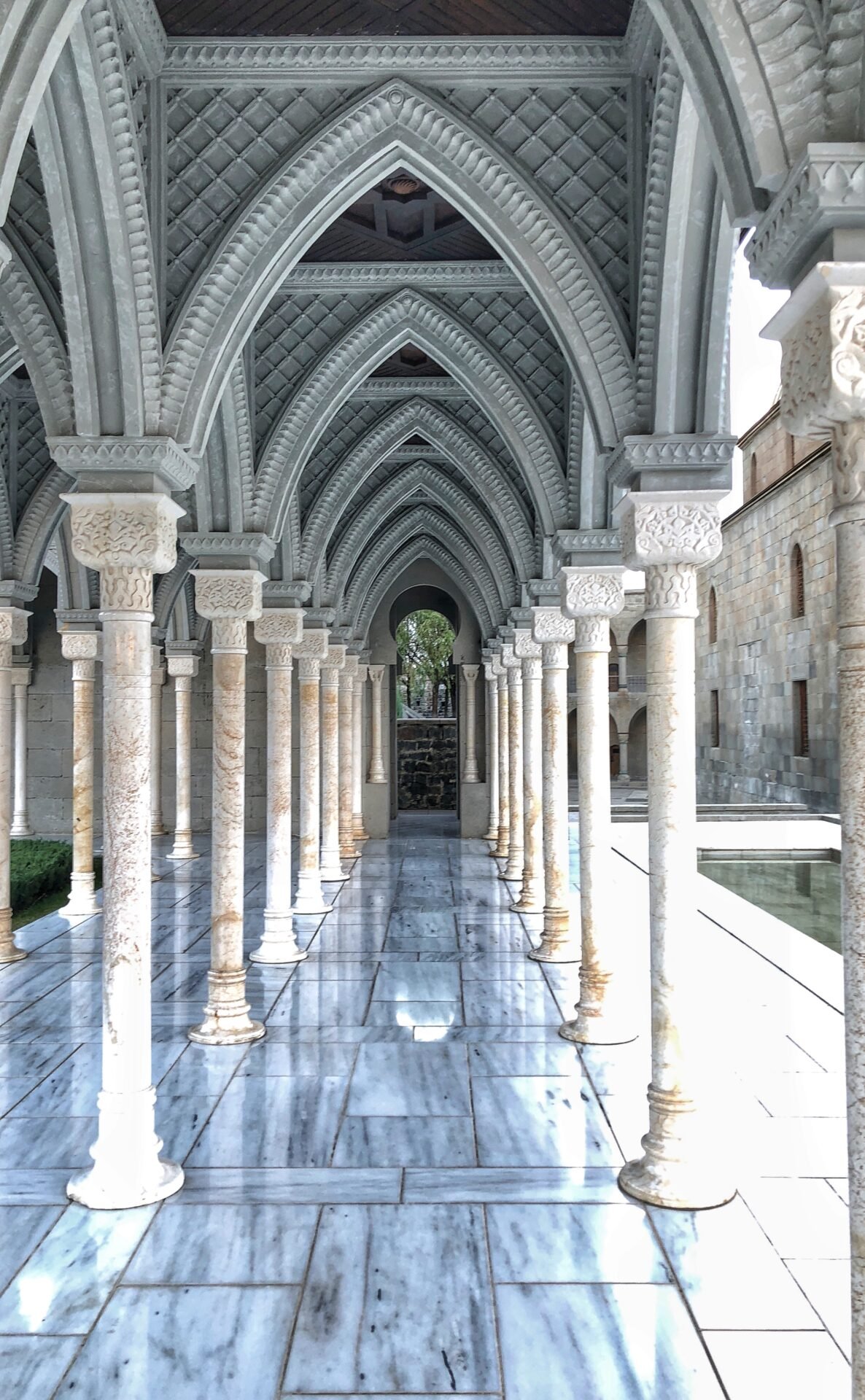
The number of architectural styles in this place was fascinating. It really spoke to the span of reconstruction periods and development as you can see from this Persian-style walkway.
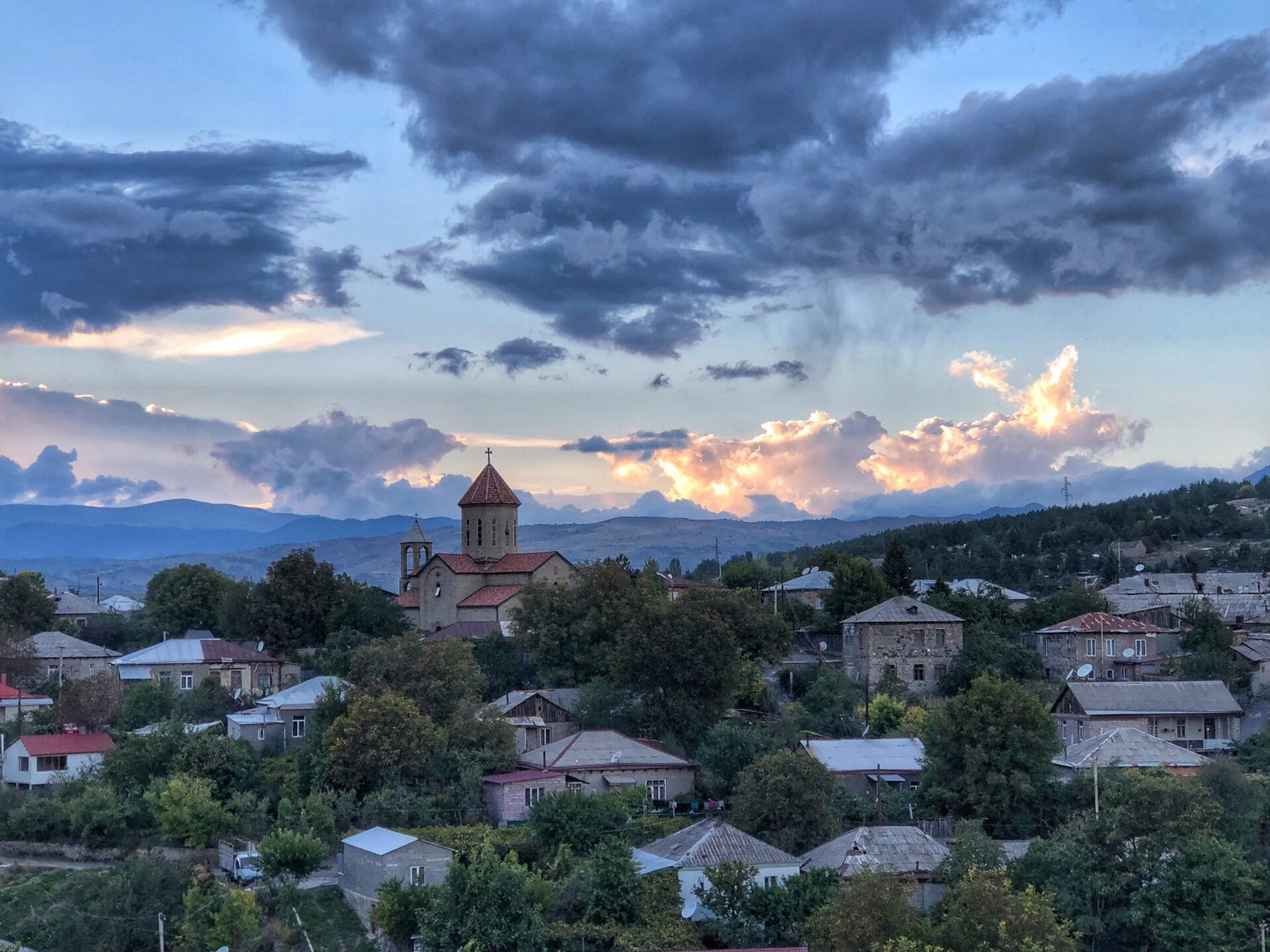
A beautiful sunset behind a Georgian church and the surrounding mountains.
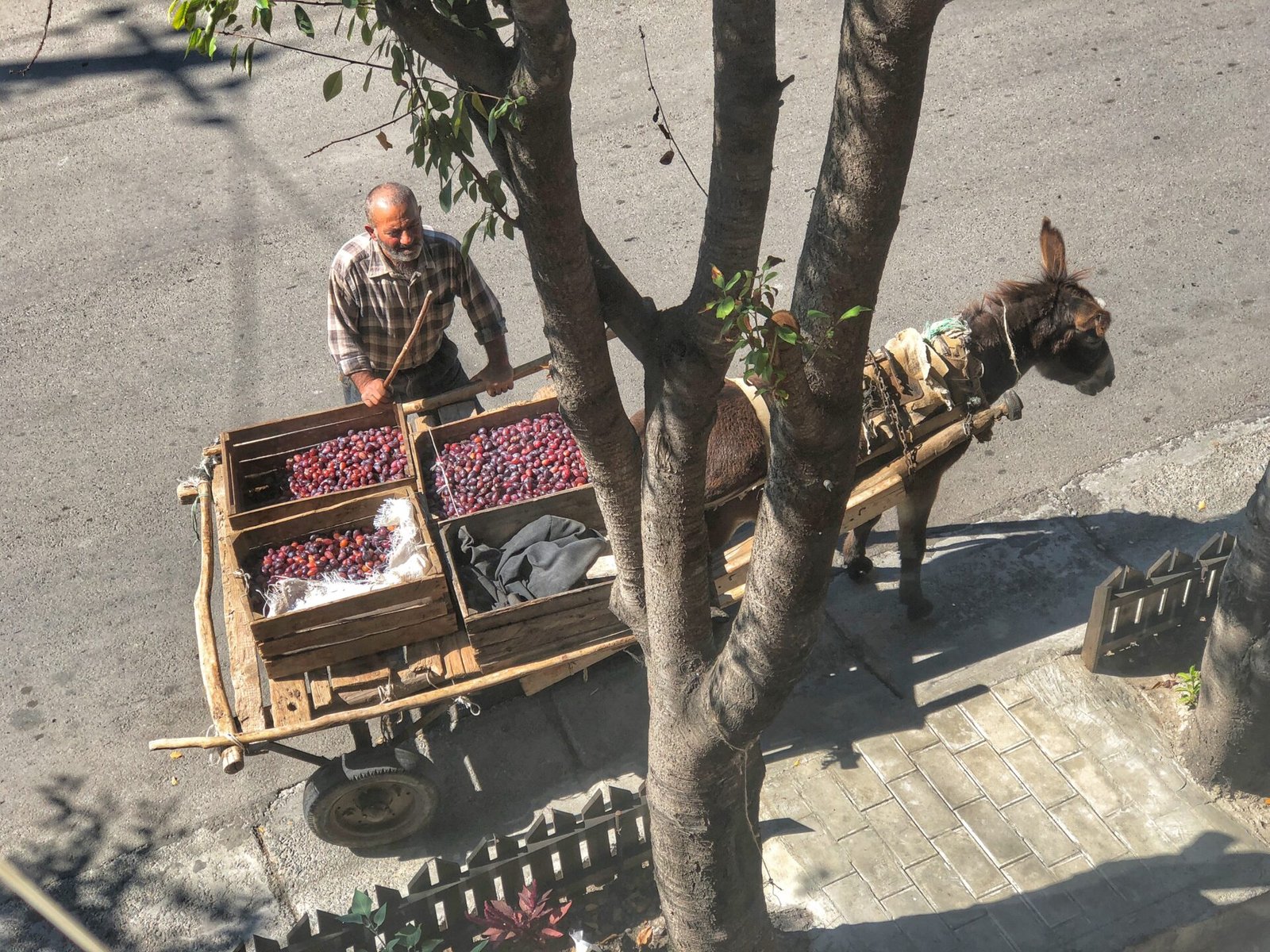
The next day, we spy from our bedroom window as Cico picks over her daily fruit delivery.
Vardzia

Visiting the cave city of Vardzia is undoubtedly like stepping into an Indiana Jones movie. This ancient city has 13 levels and 600 rooms connected by tunnels and stairways (many are secret). It was built in the 12th Century by Queen Tarmar, great granddaughter of David the Builder. There is an outdoor bell tower, monastery, library, stables, treasury, wine press and a number of “luxury apartments.” There are several monks still living in the caves today. We have never been to anything like this…Wow!
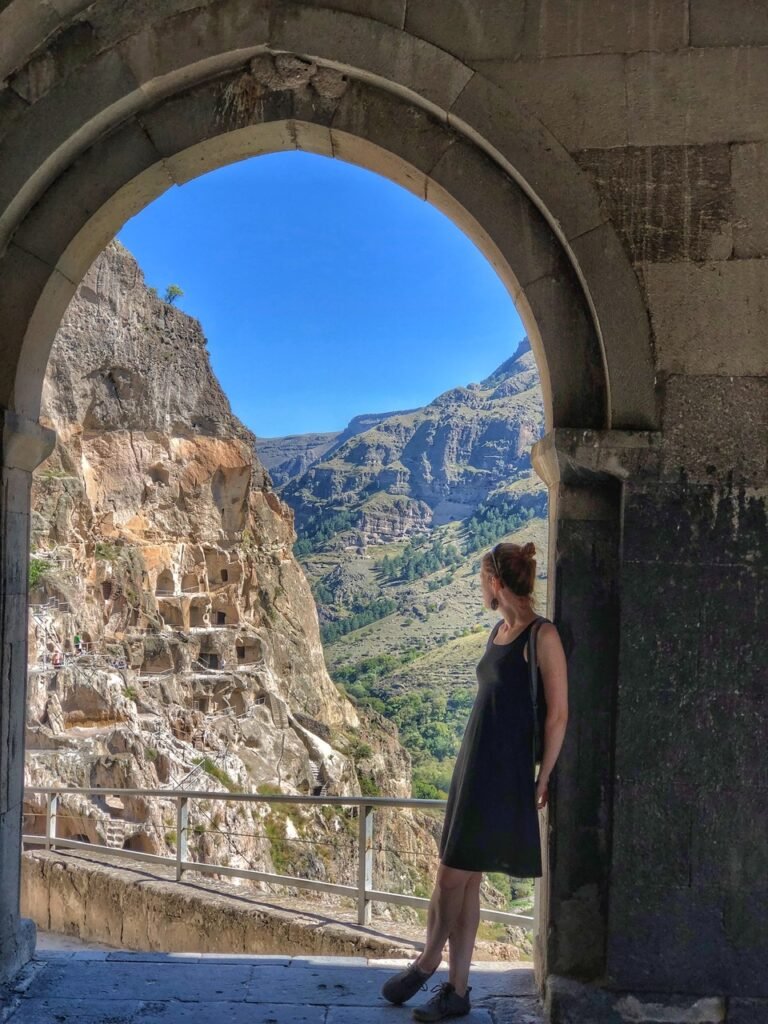

The view looking out from one of the wine press cave rooms. You can still see remnants of clay wine vessels, which were buried in earth while the wine fermented, inside the pit in this room.
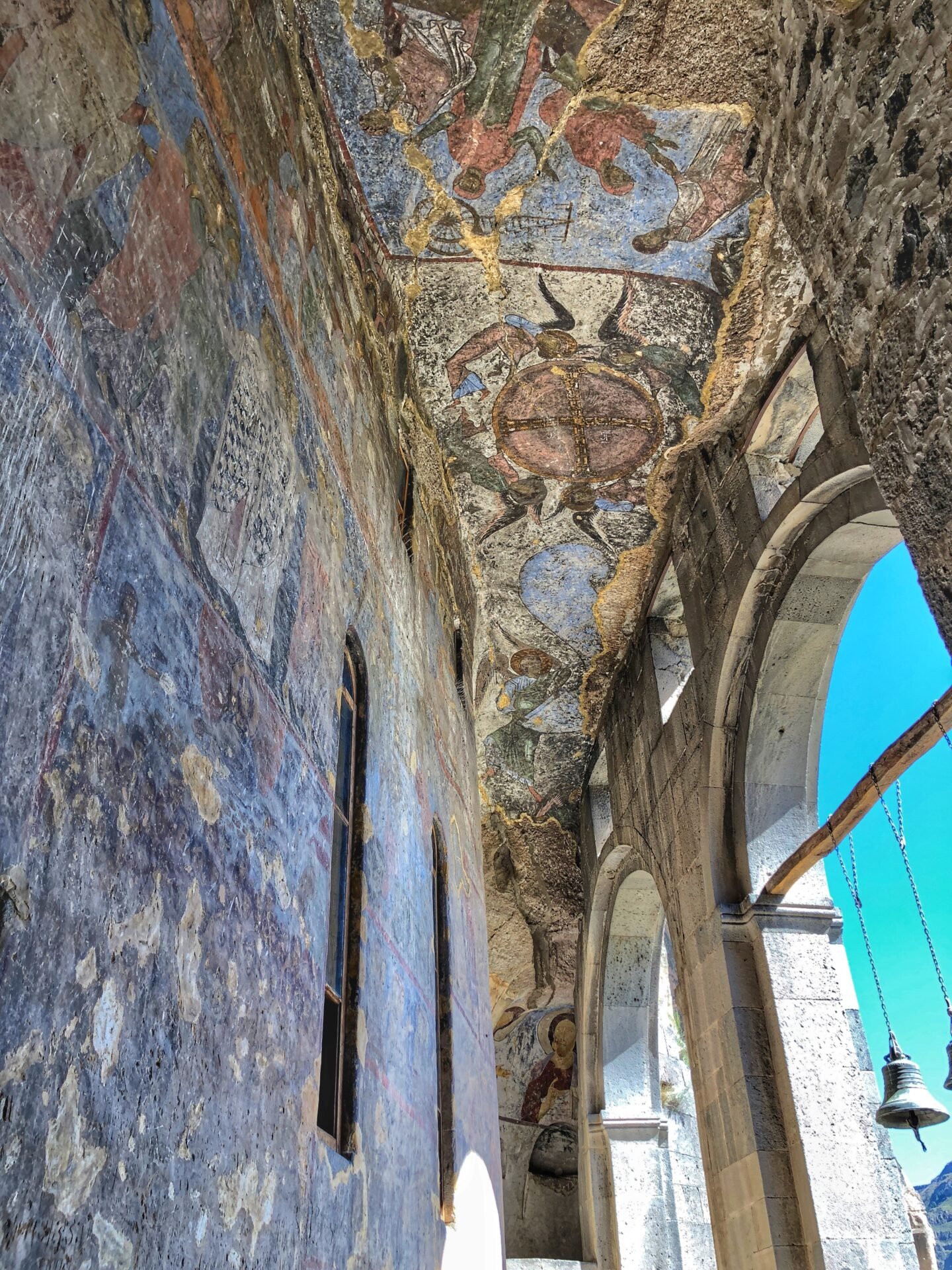
The ancient cathedral carved out of the rock at Vardzia, built in the 1180’s, still has incredibly colorful and beautifully intact frescoes outside and inside.
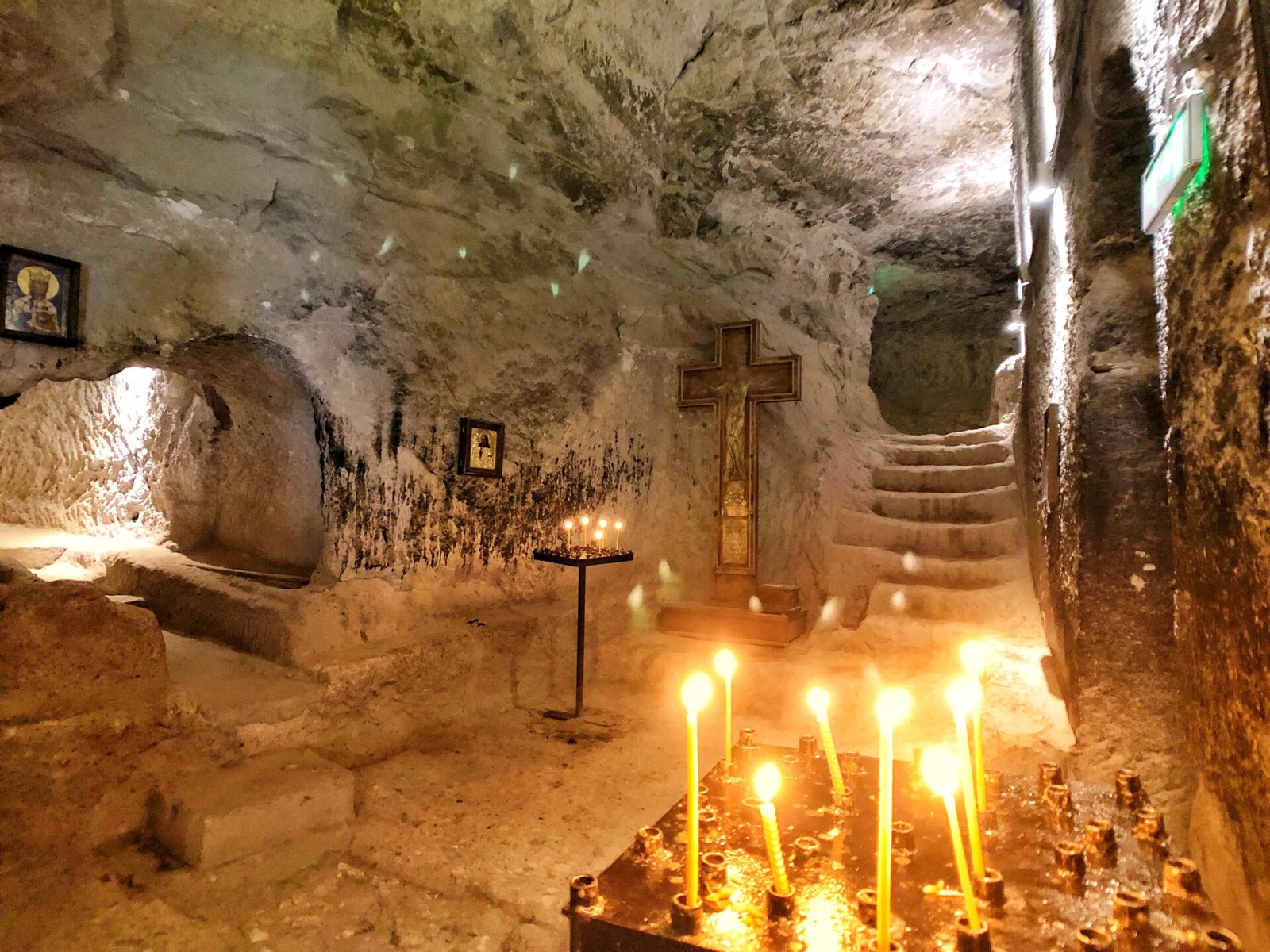
Inside a carved out tunnel and side room of the cathedral. Walking down the tunnel to the left takes you to another room containing a Holy natural spring percolating from the rock.
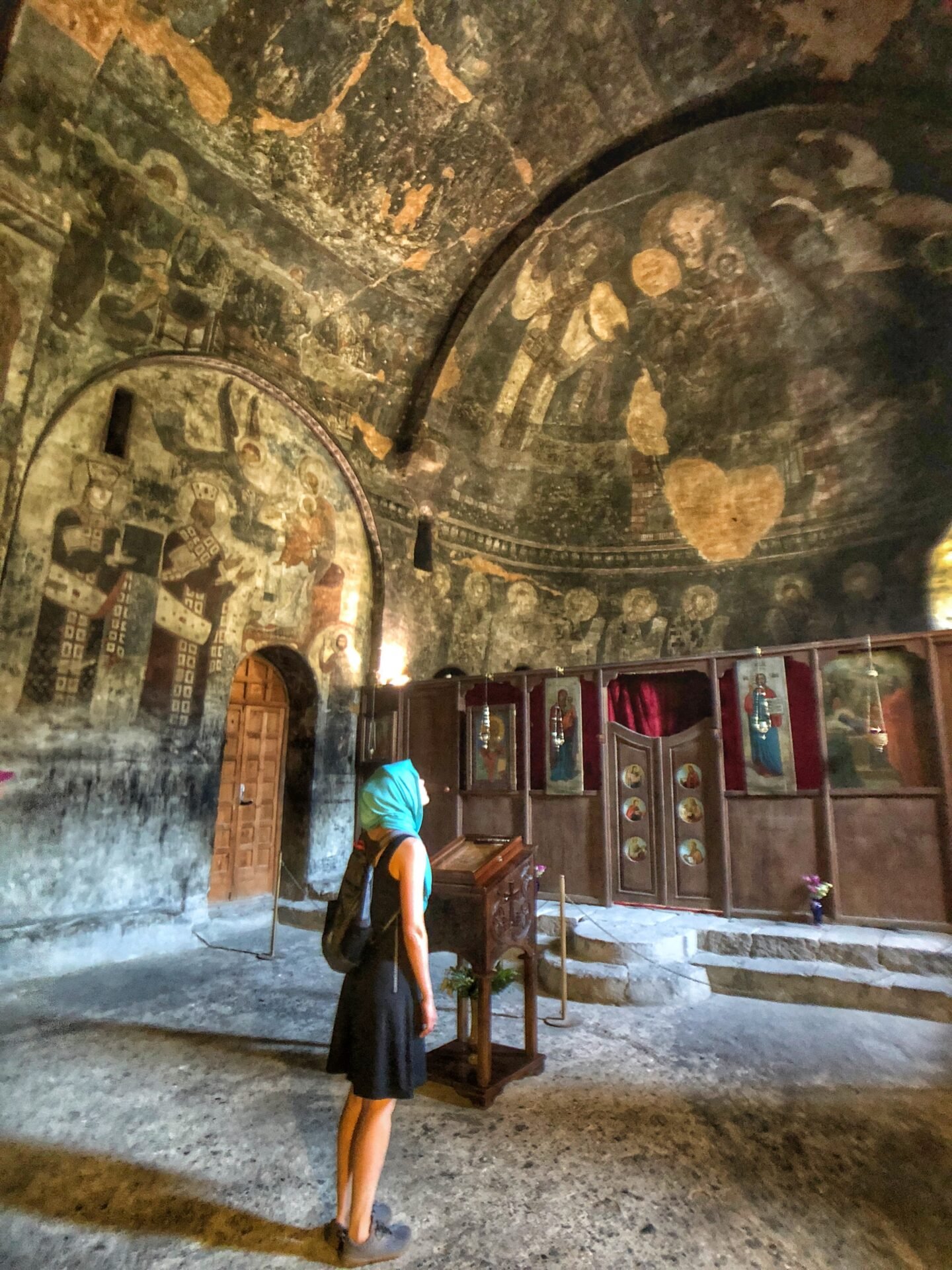
Mandy admires the remarkable frescoes painted inside the cathedral stone walls… it was truly astounding to witness this space.


Making our way between the labyrinth of tunnels winding between rooms. The longest one was ~100 meters (300 feet) carved out of solid rock and winding upward nearly ~70 meters (200 feet) in elevation before emerging at a cave room used by monks for quiet reflection and sanctuary. Some with stairs built in to go between the levels.

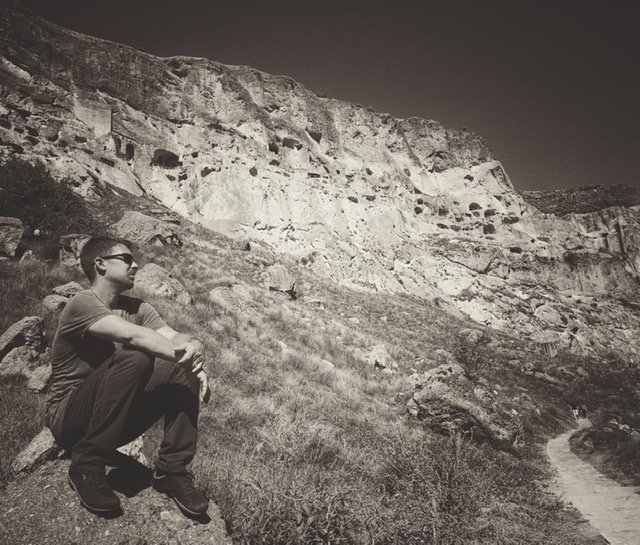

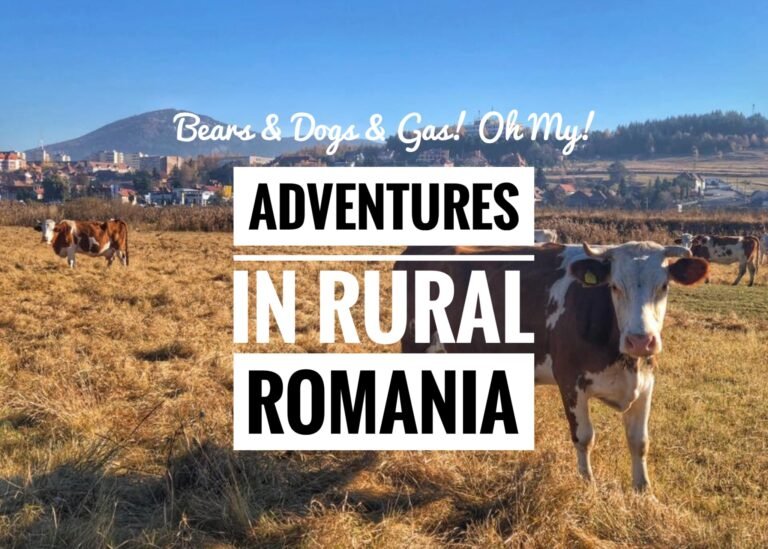


Thank you so much! Glad to hear you enjoyed it. Have you been to Georgia yet?